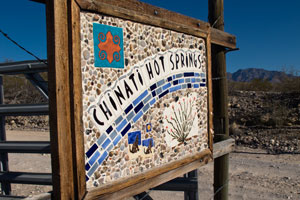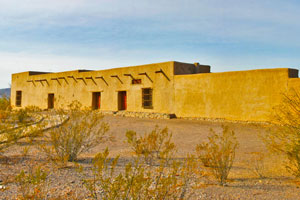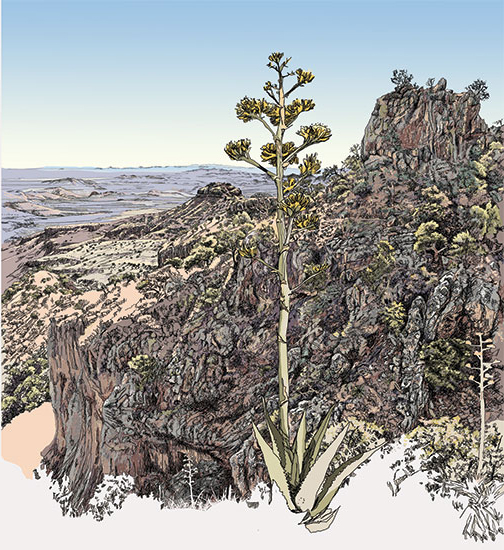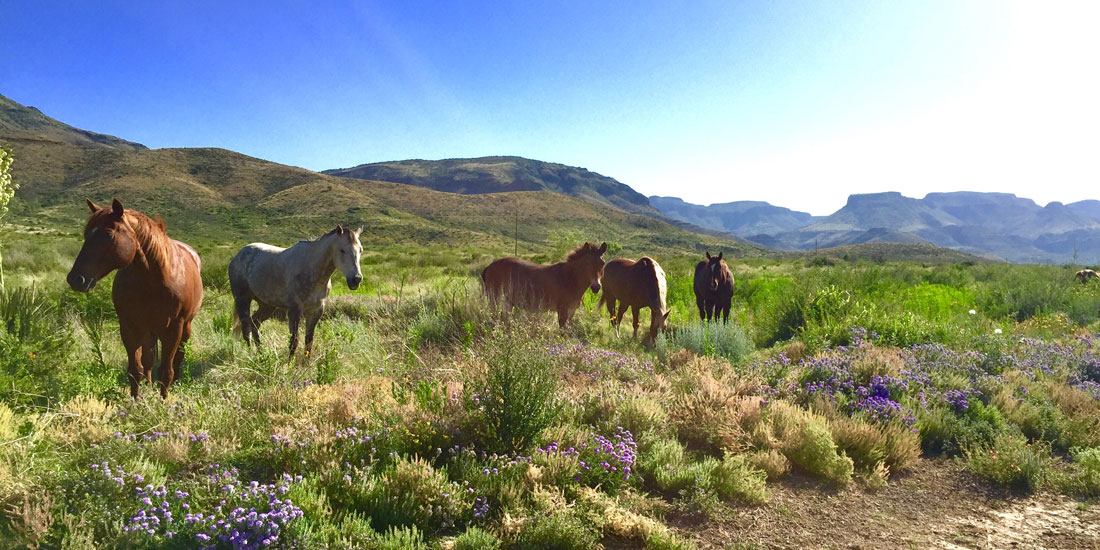Pinto Canyon and RM 2810
A One-Day to the South from Marfa
Take Ranch to Market Road 2810, also known as Pinto Canyon Road, southwest out of Marfa to experience the quiet beauty of the vast West Texas landscape. Civilization soon slips out of sight in the rearview mirror as big sky and rolling grasslands surround you. The Chinati Mountains loom on the horizon, increasing in size and ruggedness as you approach.
The first thirty miles or so are paved, but then abruptly turn to dirt as the road begins to wind along scenic switchbacks into Pinto Canyon and on to the Rio Grande. You’ll want a high-clearance vehicle with a full tank of gas, good tires and plenty of water since you won’t find many amenities in this unspoiled part of the state.
New York Times travel writer Seth Kugel tells of his trip on this route: “I made the fortuitous decision to bypass U.S. 67—the direct route to Presidio—and instead take the prettier and virtually unused Ranch Road 2810, a 44-mile strip of asphalt through dramatic emptiness that eventually turns into 10 miles of dirt road, weaving through cowboy-movie scenery of parched hills the color of toasted sand and blue skies with wispy clouds hanging along the horizon."
Stop 1: Chinati Hot Springs

The waters of Chinati Hot Springs have long been a traveler’s destination because of their restorative properties. The pools’ mineral-rich water stays at a constant 100 degrees and is believed to possess healing abilities.
Local Hispanics use the word chinati to describe the grackle, using the bird’s early arrival in spring as a sign of imminent warm weather. Apaches say the name is derived from the Apache word ch’íná’itíh, meaning “mountain pass.”
The resort was built in the 1930s and the grounds spread over 640 acres. The oasis, encompassing deep, remote canyons and riparian corridors lined with cottonwoods, attracts a variety of rare birds. Call ahead to make a reservation to ensure you’ll have a room and private pool. Take Hot Springs Road about a half-mile outside of Ruidosa to the Chinati Hot Springs gate. www.chinatihotsprings.net
Stop 2: Presidio

Originally named La Junta de los Rios, meaning “Junction of the Rivers,” Presidio is a place of profound history and natural beauty. Archaeologists unearthed traces of dinosaurs that roamed the region more than 100 million years ago and remnants of human settlements that thrived more than 1,500 years before Christ. The Spanish explorer Cabeza de Vaca arrived in this area in 1535. Comanche raids and Mexican bandits threatened settlers in the area throughout the mid- to late-19th century.
Natural marvels abound here, from the ghostly Chinati Mountains to the panoramic vistas of Big Bend Ranch State Park. Many visitors enjoy exploring the outdoors by car, motorcycle or river raft.
Outside the city a sign says, “Presidio, Tx. Welcome to the Real Frontier,” which could refer to both the town’s formidable history and its recent dramas as the fastest-growing community in Texas. The city itself boasts comfortable hotels, delightful restaurants and outstanding shopping, both in town and across the bridge in Ojinga, Chihuahua. Presidio, TX
Stop 3: Fort Leaton

Stop four miles southeast of Presidio at Fort Leaton State Historic Site for a glimpse at the area’s cultural history. The original adobe structure was a private residence dating back to the early 19th century. Indian hunter Benjamin Leaton established the fort in 1848 as a border trading post. The massive adobe fortress protected his family and employees from Indian raids. Fort Leaton State Historic Site

Chianti Mountains
The contours of the Chinati Mountains shape this drive. This small range varies in elevation from 4,605 feet (1,404 meters) above sea level to 7,728 feet (2,355 meters) at the highest point, Chinati Peak. The peak’s dome-like hump guards the southwestern horizon and can be seen in the distance even from Marfa. The elliptical mountains run from northwest to southeast for fourteen miles and is surrounded by rugged cliffs and canyons. Volcanism shaped the range, which is composed mostly of igneous and metamorphic rocks, millions of years ago. There are some large quartz monzonite intrusion domes on the west side of the Chinati Mountain caldera and many dikes of peralkaline rhyolite on the north side.
Snakes
Venomous snakes, scorpions, spiders, and centipedes are active during warm months.
Four species of rattlesnake live in this part of Texas: the western diamondback, black-tailed, rock, and Mojave. As scary as they are, they play an important role in controlling rodent populations—many of which are pests or spread disease.
The rattle of a rattlesnake is an unmistakable buzz that, once learned, stops you in your tracks. This is a good thing, as rattlesnakes use this sound as a warning when they perceive a threat. If you hear or see a rattlesnake, back away to avoid.




